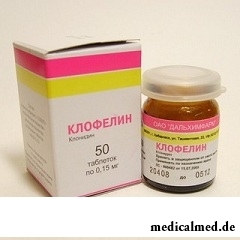





Clonidine
Application instruction:
 Clonidine – hypotensive drug.
Clonidine – hypotensive drug.
Form of release and structure
Clonidine is produced in the following dosage forms:
- Tablets (in dark glass or polymeric jars on 50 pieces, after 1 bank in a cardboard pack; in blister strip packagings on 10 pieces, on 1, 2 or 5 packagings in a cardboard pack);
- Solution for intravenous administration (in ampoules on 1 ml with a knife ampoule, on 10 ampoules in a cardboard pack);
- Drops eye (in tubes droppers on 1,3 ml, on 5 tubes in a cardboard pack).
Is a part of 1 tablet:
- Active agent: a clonidine – 0,075 or 0,15 mg (in the form of a hydrochloride);
- Auxiliary components: monohydrate of lactose (milk sugar) – 47,925/133,35 mg, potato starch – 11,4/15 mg, magnesium stearate – 0,6/1,5 mg.
For intravenous administration is a part of 1 ml of solution:
- Active agent: a clonidine – 0,1 mg (in the form of a hydrochloride);
- Auxiliary components: 0,1 M Acidum hydrochloricum solution – to рН 4-5,5, water for injections – to 1 ml.
Eye is a part of 1 ml of drops:
- Active agent: a clonidine – 1,25, 2,5 or 5 mg (in the form of a hydrochloride);
- Auxiliary components: sodium chloride, a dihydrate dihydrosodium phosphate, dodecahydrate hydrosodium phosphate, water for injections.
Indications to use
- Tablets: arterial hypertension;
- Solution for intravenous administration: stopping of hypertensive crisis;
- Drops are eye: primary open angle glaucoma with moderately increased or high intraocular pressure and the stabilized visual functions.
Contraindications
- The expressed atherosclerotic changes of vessels of a brain;
- Depression;
- Arterial hypotension;
- Pregnancy and period of a lactation;
- Age up to 18 years (efficiency and safety of use of Clonidine for this group of patients is not established);
- Hypersensitivity to drug components.
In addition contraindications to use of Clonidine in the form of tablets and solution for injections are:
- Atrioventricular block of II and III degrees;
- The expressed sinus bradycardia;
- Cardiogenic shock;
- Sick sinus syndrome;
- Obliterating diseases of arteries;
- Simultaneous use with tricyclic antidepressants and ethanol.
Drug should be used with care the patient after recently postponed myocardial infarction, and also to patients with a chronic renal failure and an atrioventricular block of the I degree.
Route of administration and dosage
Clonidine in the form of tablets is accepted inside, without chewing and washing down with a small amount of liquid, it is more preferable – in time or after food.
Drug is effective in rather small doses (the doctor sets the dosing mode individually).
Therapy is begun, as a rule, with small doses (2-3 times a day on 0,075 mg). At insufficiency of anti-hypertensive effect perhaps gradual (each 1-2 days on 0,0375 mg) increase in a single dose up to 0,15 mg.
At elderly patients, in particular at manifestations of an angiosclerosis of a brain, treatment begin with a dose 0,0375 mg (because of possible existence of hypersensitivity to drug components).
Usually daily doses fluctuate within 0,3-0,45 mg, in some cases – 1,2-1,5 mg. The maximum single dose – 0,3 mg, daily – 2,4 mg.
Solution of Clonidine is entered intravenously. The doctor selects doses individually.
For intravenous administration of 0,5-1,5 ml of solution of Clonidine dissolve 0,9% of solution of sodium chloride in 10-20 ml. The drug is administered slowly – for 3-5 minutes.
For drop introduction of 4 ml of solution it is necessary to dissolve 5% of solution of glucose in 500 ml. Introduction is carried out with an average speed – 20 drops a minute. The maximum speed of infusion – 120 drops a minute. In stationary conditions it is possible to enter Clonidine parenterally 3-4 times a day.
Drops eye apply in the form of instillations. A single dose – 1 drop, frequency rate of use – 2-4 times a day. At insufficient effect performing the combined treatment is possible (along with miotika).
Therapy is begun with 0,25% of solution. At insufficient decrease in intraocular pressure pass to use 0,5% of solution, at development of side effects – 0,125% of solution.
Side effects
At Clonidine use inside and intravenously possibly development of the following side effects (very often – from 1/10; often – from 1/100 and to 1/10; infrequently – from 1/1000 and to 1/100; seldom – from 1/10000 and to 1/1000; very seldom – to 1/10000, including single messages):
- Cardiovascular system: in rare instances at the beginning of therapy – short-term paradoxical increase in arterial pressure; very often – orthostatic hypotension; infrequently – Reynaud's syndrome, a sinus bradycardia; seldom – an atrioventricular block; with an unknown frequency – a bradyarrhythmia;
- Alimentary system: very often – dryness of a mucous membrane of an oral cavity; often – a lock, nausea, a loss of appetite, pain in sialadens, decrease in gastric secretion, vomiting; seldom – pseudo-obstruction of a large intestine; with an unknown frequency – hepatitis;
- Central nervous system: very often – drowsiness, dizziness, increased fatigue, delay of speed of motor and mental reactions; often – sleep disorders, nervousness, a headache, a depression; infrequently – paresthesias; seldom – perception disturbance, an adynamy, hallucinations, "dreadful" or bright dreams; with an unknown frequency – confusion of consciousness;
- Respiratory system: seldom – a xeromycteria;
- Reproductive system: often – erectile dysfunction; with an unknown frequency – decrease in a libido; seldom – a gynecomastia;
- Integuments: infrequently – rash (including a small tortoiseshell), a skin itch; seldom – an alopecia;
- Sense bodys: seldom – decrease in a slezootdeleniye; with an unknown frequency – accommodation disturbance;
- Laboratory indicators: seldom – a hyperglycemia; with an unknown frequency – change of functional trials of a liver;
- Others: with an unknown frequency – Reynaud's phenomenon, the delay of water and sodium which is shown hypostases of anklebones and feet; infrequently – a nose congestion; at sudden cancellation – a syndrome of "cancellation".
At use of Clonidine in the form of eye drops there can be such disturbances as: bradycardia, weakness, dryness in a mouth, drowsiness, an excessive lowering of arterial pressure, feeling of a foreign subject or burning in an eye.
Special instructions
During use of Clonidine it is forbidden to take alcoholic drinks.
Duration of a course of therapy is defined by the received results. In order to avoid development of a withdrawal the termination of administration of drug is carried out gradually for 7-10 days. In case of development of a syndrome it is necessary to return at once to Clonidine reception, further it is cancelled gradually with replacement with other anti-hypertensive drugs.
At intravenous use of Clonidine for prevention of developing of orthostatic hypotension the patient needs to be in a prone position during administration of drug and within 1,5-2 hours after the end of a procedure.
In the absence of effect in the first 2 days of use of eye drops therapy is cancelled.
It is necessary to consider that Klofelin in all dosage forms lowers physical and mental reactions at different types of operator activity. Treatment of patients whose work demands bystry physical and mental reaction (drivers, pilots, etc.) is recommended to be carried out only in stationary conditions or it is out-patient with release for the period of treatment for work.
Medicinal interaction
At simultaneous use of Clonidine with some medicines there can be following effects:
- The drugs oppressing the central nervous system: development of depressive frustration and strengthening of the depriving of bonuses influence on the central nervous system;
- Tricyclic antidepressants, sympathomimetic, anorexigenic (except a fenfluramin) medicines, nifedipine and non-steroidal anti-inflammatory drugs: easing of hypotensive effect of Clonidine;
- Cardiac glycosides and beta adrenoblockers: increase in risk of development of bradycardia or (in some cases) atrioventricular block;
- Atenolol, propranolol: development of the additive hypotensive effect, sedative action, dryness in a mouth;
- Levodopa, piribedit: reduction of their efficiency;
- Diuretics, vazodilatator, antihistamines: increase in hypotensive effect of Clonidine;
- Prazozinum: change of anti-hypertensive action of a clonidine;
- Cyclosporine: increase in its concentration in a blood plasma;
- Hormonal contraceptives for intake: strengthening of sedative action of a clonidine;
- Tolperisonum: strengthening of myorelaxation action;
- Tofizopamum: strengthening of anxiolytic action;
- Phenylephrinum: strengthening of pressor effect;
- Mirtazapin: development of hypertensive crisis;
- Haloperidol: strengthening of oppression of the central nervous system;
- Sulpiridum: strengthening of effect of a clonidine;
- Insulin, hypoglycemic means for intake: weakening of hypoglycemic effect of Clonidine.
Terms and storage conditions
To store in protected from light, the place, unavailable to children.
Period of validity:
- Drops eye – 2 years at a temperature up to 15 °C;
- Solution for intravenous administration – 3 years at a temperature up to 30 °C;
- Tablets – 4 years at a temperature up to 30 °C.
If your liver ceased to work, death would come within a day.

It is difficult to revaluate importance of kidneys for an organism. These bodies not only perform work on purification of blood of decomposition products and выв...
Section: Articles about health
Milk and products of its processing by right occupy one of the main places in a diet of the modern person. They contain proteins, necessary for normal life activity, fats, vitamins and microelements, and are an important part of various medical diets....
Section: Articles about health
The hysteromyoma is diagnosed more than at a third of women 35 years are more senior. This high-quality new growth which at early stages successfully resolves by means of medicines. It is necessary to resort to an operative measure only when patients too late address specialists, or therapeutic methods do not give the expected effect because of specific features of an organism. Besides, there is a large number of quite effective national...
Section: Articles about health
High temperature - a frequent symptom of such widespread diseases as a SARS, quinsy, pneumonia, etc. To reduce heat, облег...
Section: Articles about health
Eyes – one of the most vulnerable areas on a face therefore age changes concern them first of all. Whether it is possible to keep look youth for many years and what procedures are offered for achievement of this purpose by cosmetologists? And maybe, only thing of a vari...
Section: Articles about health
Vitamin complexes belong to the most popular drugs, probably, in our country there is no person who was not hearing about advantage of vitamins and never their accepting. The more vitamins, the better, we consider and as it appeared, cruelly we are mistaken. Whether vitamins, whether so harmlessly general hobby for polyvitaminic complexes and whether it is possible to do without them are so useful? Let's try to understand....
Section: Articles about health
The climax, or menopause is the normal process of the termination of genital function of the woman which is followed serious hormonal...
Section: Articles about health
For the person who daily since morning gathers for work it is very important to wake up vigorous and ready by day of work. Actually, each of us experiences difficulties with this, at first sight, simple business from time to time. On a condition of an organism after ночн...
Section: Articles about health
For many women the word "fat" sounds as a sentence. In aspiration to an ideal figure they try to exclude, first of all, from the menu all dishes containing fats without having at the same time a clear idea of a role of these substances in exchange processes, and of effects for health with which food restrictions of this sort are fraught. For what the human body needs fats and as their deficit in a diet is shown, we also will try to find out....
Section: Articles about health
Several decades ago the basil (the district khan, реан, Reagan) was considered as a part of the Caucasian or east cuisine, but today it is strong for...
Section: Articles about health
Frosty air, fresh wind and easy snowball at most of Russians are associated with cheerfulness, health and cheerful entertainments on which our winter is so generous. But, unfortunately, cold season sometimes brings also troubles with health. It is not about a season...
Section: Articles about health
Feeding by a breast - the integral part of ideal motherhood allowing to come into contact with the kid and to create to it healthy immunity since early years. Nevertheless, this important process in life of mother and child can be saddened laktostazy − by a milk delay in a mammary gland. What main reasons for a laktostaz? How not to allow problems with breastfeeding? Let's consider 10 premises resulting in stagnation of milk at the nursing mother....
Section: Articles about health
Life of the modern woman is very difficult. Opportunities to realize itself are wide: it not only education and career, but also most differently...
Section: Articles about health
Subfebrile temperature call fervescence to 38 degrees, and subfebrile condition - existence of such temperature over 3 days, and quite often it happens without the visible reasons. Existence of subfebrile condition - a strong indication of disturbances in an organism which can...
Section: Articles about health
What they, women? Beautiful, gentle, passionate and at the same time windy, gusty, and nervous. And what is stranger: have all these qualities of the woman at the same time. But here only the mood their time sharply changes on completely opposite: in the morning they laugh and joke, and in the evening cry or are irritated....
Section: Articles about health
The phenomenon of improvement of a condition of the patients at administration of drugs who are not containing active agents, so-called effect of placebo is known...
Section: Articles about health
There is an opinion that at low temperatures safety of products is ensured longer and better thanks to what the refrigerator is considered the most suitable place for storage of food. In most cases it is fair, however there is a number of products, for a kotor...
Section: Articles about health
An eye of the person daily experiences considerable strain. The problem of preservation of sight is for many years directly connected with a question of supply of tissues of eye enough oxygen and nutrients. This task is carried out by small vessels – capillaries. For normal functioning of the visual device extremely important that they kept the integrity, but it works well not always. Microtraumas of eye vessels during which there are small hemorrhages it is extraordinary расп...
Section: Articles about health
Smoking not only exerts a negative impact on the state of health of the consumer of tobacco products, but is a source з...
Section: Articles about health
Modern footwear is extremely various. It stopped being only protection for legs long ago. Today shoes, boots, barefoot persons choose not so much proceeding from their convenience and functionality how many being guided by outward, brand and an opportunity to add with it...
Section: Articles about health
Reactive pancreatitis - the disease which is characterized by inflammatory process in a pancreas which arises most often because of excess activity of digestive enzymes. It − the emergency state which treatment has to take place in surgical department under control of doctors. The acute inflammation of gland can become the reason of its transition to a chronic form, and also development is purulent - necrotic pancreatitis which the extensive necrosis of fabrics can follow. Zabolev...
Section: Articles about health
No, probably, the person who would not have cold. Cold, cough, a headache – these symptoms are known to everyone. Peak to Prost...
Section: Articles about health
One of the major chemical processes happening in a human body are oxidation reactions. They go with participation of fats and carbohydrates which we receive from food, and the oxygen getting to us from air. A main goal of such reactions is it is received...
Section: Articles about health
Nightmares belong to the most unpleasant frustration. Statistically, they happen at 4% of adults, and almost at 70% of children and teenagers. During a nightmare of people dreams himself in extremely difficult, life-threatening situation. He wakens suddenly, in a condition of a fright, and, as a rule, remembers the dream distinctly. The feeling of depression and alarm does not release throughout the day, creating hindrances for work and normal communication. If such episodes repeat often, can р...
Section: Articles about health
To look healthy and means well-groomed not only to be pleasant to people around, but also to feel strong, sure and taken place. To Spa...
Section: Articles about health
Coffee - the tonic loved by many for the invigorating aroma and deep taste. Having the stimulating effect, coffee increases working capacity, promotes concentration of attention, fights against drowsiness and improves mood. Statistically, about 30% of inhabitants...
Section: Articles about health
The naturopathy sometimes moves as the new direction of medicine, something like fashionable hobby, and there is nothing farther from the truth. This most ancient direction, the word "naturopathy" is translated as "treatment by the nature", and, no doubt, treatment by natural gifts was the first and only, available to the person in ancient times. Despite modern achievements of medicine, the naturopathy remains urgent and today, anyway the person - a part of the nature, and природн...
Section: Articles about health
